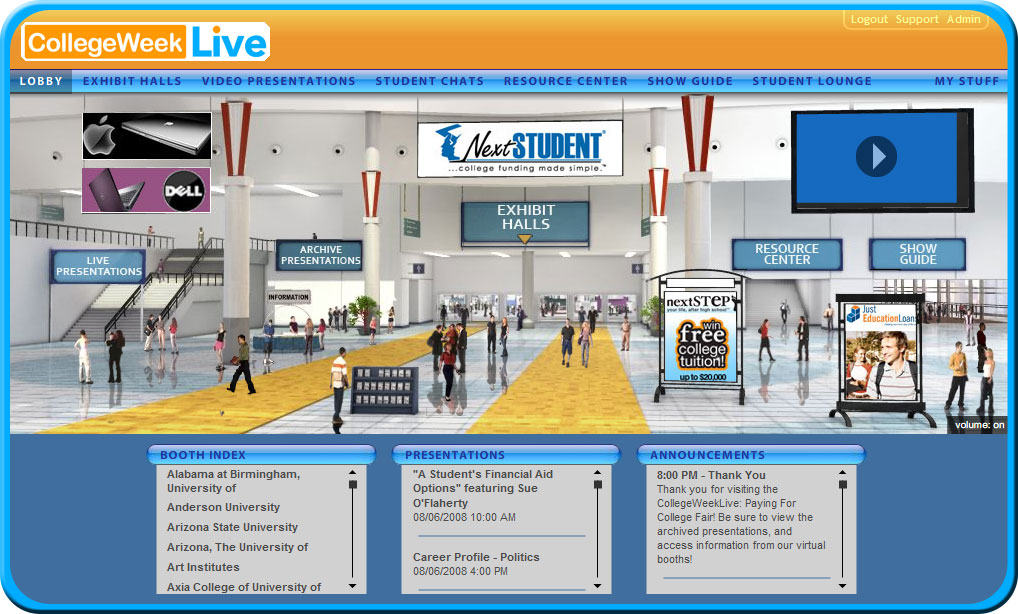On March 25th and 26th, CollegeWeekLive held it’s fourth virtual college fair through producer PlatformQ.
In their words, “CollegeWeekLive is the world’s biggest virtual college fair, with more than 200 colleges and universities from around the world exhibiting and more than 25,000 attendees. The event revolutionizes college admissions, making the process easier and more cost-effective by bringing together students, parents, counselors and colleges online to interact, transcending time and distance.
From the lobby, attendees can break off into a several areas. Students are able to talk to admissions experts on a variety of topics - such as financial aid or essay writing - and can also experience various forms of collateral from each participating school to get a better sense of what college is like on their campus. Within each university’s virtual booth their are live chats with current students, faculty and admissions officers as well as videos and electronic brochures to offer as complete a set of information on the school as possible. They also have keynotes periodically throughout the day on topics like preparing for the SATs.
CollegeWeekLive is responding to recent trends in both virtual conferencing and the propensity to accomplish processes in an online setting, especially for the demographic targeted by the conference.
A recent survey of college-seeking high school students, conducted by CollegeWeekLive.com, asked for comments about how the college admissions process could be improved. The comments highlighted frustration with paper communication and a preference for online communications: “Use the internet to promote. It’s easier, takes up no paper, and students won’t have to bother with the multitude of brochures from unsolicited schools.”
In a discussion with Martha Collins, VP of Marketing, we gained some insight into the process:
You’ve done a few of these now. What have you noticed about the technological uptake on the part of the universities? Did you come across any issues? Has it improved with each one?
We’re seeing more and more schools understand that meeting the students online makes a lot of sense. They’re online and they need to be there. The way the connections happen in this setting are a lot more comfortable and casual. A student can be watching a presentation - live-streaming - and text in a question, which is much easier for a high school student to do in that context. They’re at the stage of life where they’re still a little timid and they’re much more comfortable in the environment.
In terms of the technology, many colleges have exhibited several times with us, and they’re the ones leading the pack. The colleges realize how important it is to be there and be present and available in the booth. For the high school students, the late afternoons and evenings are the most popular times to visit the conference, so the schools have found how important it is to be online in those peak hours and appreciate the students’ schedule.
In the broader context of online admissions, some colleges are recruiting more proactively online than others, and some of them are still going the traditional route. Frankly, I’ve signed up for some of the services the students go through, and the amount of paper admissions information that students receive is overwhelming. Teens are not only wanting more of a conversation about these things, but they’re also becoming more increasingly green conscious, and this may affect their perception of a college. Whereas online, the students can choose when they want to speak to whom, how much information they want, or how much interaction they want. The relationship is more accommodating to their desire to gather information, which the universities are realizing as being, in the end, more beneficial to the process.
Were there any large lessons learned on the part of Platform Q?
Don’t underestimate the technology. From the attendee standpoint, people sometimes don’t appreciate that we’re putting together a virtual tradeshow on an online platform, and it’s pretty darn sophisticated. We’re getting tens of thousands of kids in there in a 24-hour period, and we’re pushing the envelope in terms of the technology. I think a lot of people think that it’s a webinar, just a webinar. It’s a lot more than a webinar. We’re streaming a ton of content from around the country, and a ton of attendees are viewing it. There has been a lot of learning in terms of combining the technology over time, and optimizing the best tool set to get the job done.
In general, why do you think people are choosing to use a virtual conference format more now? What are the pros and cons?
For admissions, it’s transcending time and distance. It’s an opportunity for colleges to reach a much broader audience geographically. Over 30% of our attendees are international. It’s 100% free to the students, and we have several partnerships in place that make it available to socio-economically disadvantaged students, so it really levels the playing field.
On the admissions side, everyone is concerned with budgets, and this is a great opportunity to increase your general reach at a very low cost. So while there may be technological barriers for some, most are willing to overcome those.
The next college fair will be held on 16 July, everywhere.
Related articles by Zemanta
- CollegeWeekLive Announces Free “Counselors on Call” for March 25-26 Online College Fair (seomashup.blogspot.com)
- Getting into college: Admissions officers talk candidly (connectwithyourteens.blogspot.com)
- Decline of Colleges? (stat.columbia.edu)
Tags: Colleges and Universities, CollegeWeekLive.com, education, higher ed, Martha Collins, PlatformQ, University and college admissions, virtual conference












Add New Comment
Viewing 1 Comment
Thanks. Your comment is awaiting approval by a moderator.
Do you already have an account? Log in and claim this comment.
Do you already have an account? Log in and claim this comment.
Add New Comment
Trackbacks